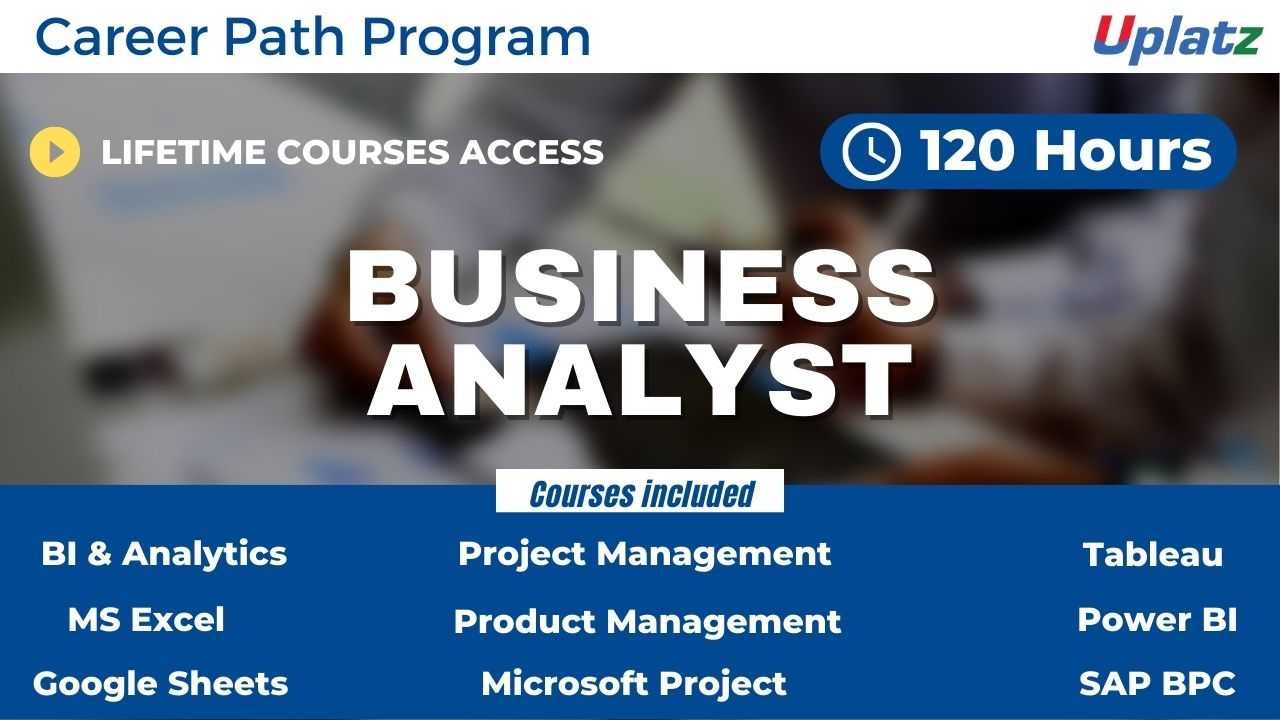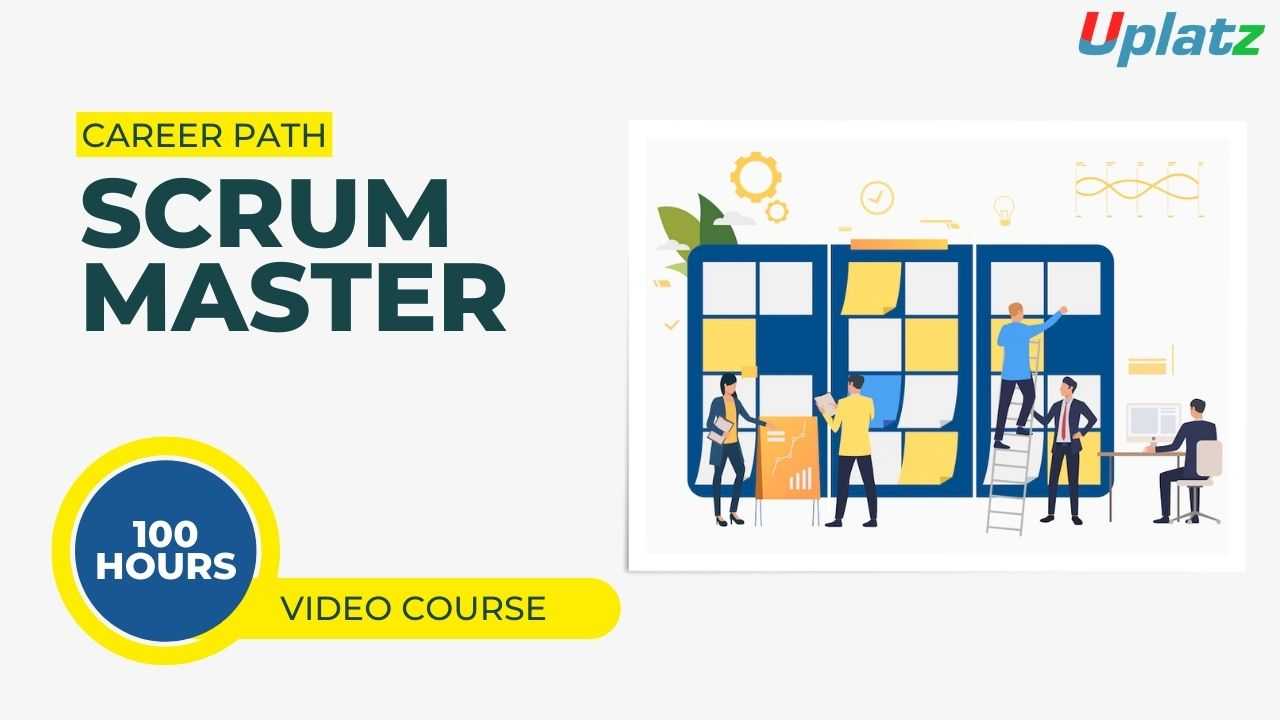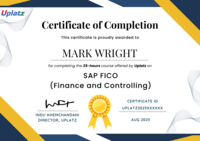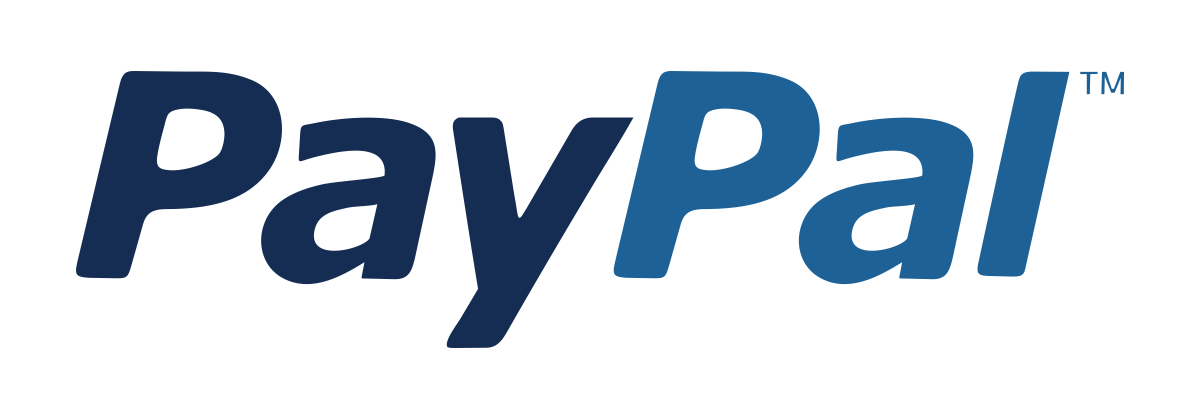Career Path - Product Owner
Become an Agile product owner, or Scrum product owner. Be responsible for maximizing the value of the products and lead areas of product development.Preview Career Path - Product Owner course
Price Match Guarantee Full Lifetime Access Access on any Device Technical Support Secure Checkout Course Completion Certificate 86% Started a new career
BUY THIS COURSE (
86% Started a new career
BUY THIS COURSE (GBP 32 GBP 99 )-
 90% Got a pay increase and promotion
90% Got a pay increase and promotion
Students also bought -
-

- Career Path - Product Manager
- 100 Hours
- GBP 32
- 247 Learners
-

- Career Path - Business Analyst
- 120 Hours
- GBP 32
- 612 Learners
-

- Career Path - Scrum Master
- 100 Hours
- GBP 32
- 209 Learners

The courses included in the Product Owner career path program are:
1.Leadership and Management
2.Product Management
A Product Owner is responsible for ensuring the success of a project in Scrum. The product owner is responsible for managing and optimizing the product backlog in order to maximize the value of the product. A Scrum framework is an Agile methodology that facilitates communication and self-organization within a team.A Product Owner is part of the scrum team.
The key responsibilities of a Product Owner are to define user stories and create a product backlog. The Product Owner is the primary point of contact on behalf of the customer to identify the product requirements for the development team. This product backlog will be a prioritized set of customer requirements.
The Product Owner has the complete responsibility and ownership of defining and even prioritizing user requirements. The Product Owner must communicate with the development team to explain the product features to be implemented. Any queries that come from the development team must be addressed by the Product Owner on key user requirements. The role of the Product Owner is to maximize the value addition of the products that are developed by the agile scrum team.
The Product Owner must ensure that the user stories meet customer requirements. The role of the Product Owner is critical for companies that are keen to move to an agile-based product development methodology. The Product Owner has to collaborate and work closely with various stakeholders such as customers, business leaders, development teams, project managers, and other stakeholders. Product owners play an important role in Scrum because they serve as a liaison between different departments within an organization. Keeping all areas of the business informed about the progress of a project is the responsibility of this individual, who communicates with business stakeholders and works closely with Scrum teams.
A Product Owner needs to ensure and realize maximum value for the organization, from the product development process. This essentially means collaborating closely with the development team and ensuring all the product requirements are well defined and executed in time. A Product Owner plays a key role in the Scrum team, along with the Scrum master and the development team. However, the responsibilities of the scrum master are different and the Product Owner must ensure that the responsibilities of the two roles do not overlap each other. One of the main roles of a Product Owner is to manage the product backlog.
Uplatz provides this comprehensive Product Owner career path program to help you gain skills to become a successful product owner.
Course/Topic 1 - Leadership and Management - all lectures
-
In this lecture session we learn about honesty and integrity in leadership and management and also talk about some basic terms of leadership and management.
-
In this lecture session we learn about how confidence is a must in leadership and management and also talk about the importance of confidence in leadership and management.
-
In this tutorial we learn about A soft skill is a personal attribute that supports situational awareness and enhances an individual's ability to get a job done. The term soft skills is often used as a synonym for people skills or emotional intelligence.
-
In this lecture session we learn about Soft skills, also called people skills, are the mix of social and interpersonal skills, character traits, and professional attitudes that all jobs require. Teamwork, patience, time management, communication, are just a few examples.
-
In this lecture session we learn that Communication in teams is more than just efficient work. It allows everyone on the team to be educated on any topic that may affect their work. Moreover, it develops trust, builds camaraderie among the team members, boosts morale, and helps employees stay engaged in the workplace.
-
In this lecture session we learn about Effective communication can help to foster a good working relationship between you and your staff, which can in turn improve morale and efficiency.
-
In this lecture session we learn about what commitment Concentration – leadership commitment involves making a personal decision to support the change no matter what. It is incongruous to ask for change in others while failing to exhibit the same level of commitment. Concentration requires maintaining focus throughout the change not just at the beginning.
-
In this lecture session we learn about Market leadership is the position of a company with the largest market share or highest profitability margin in a given market for goods and services. Market share may be measured by either the volume of goods sold or the value of those goods.
-
In this lecture session we learn that Motivational leadership is defined by positivity and vision. Motivational leaders make decisions, set clear goals and provide their teams with the empowerment and tools to achieve success. Motivational leaders evoke and see the best in their employees, inspiring them to work toward a common goal.
-
In this lecture session we learn about A primary task of leadership is to direct attention. To do so, leaders must learn to focus their own attention. When we speak about being focused, we commonly mean thinking about one thing while filtering out distractions.
-
In this tutorial we learn about Marketing analytics helps collect and strengthen data from across all marketing channels. This information is key to improving marketing efforts and driving them forward to achieve business goals.
-
In this lecture session we learn about Marketing automation is the integration of data and processes from other sales and marketing channels into an organized central platform. A comprehensive marketing automation hub complements and organizes the customer journey. It integrates all of a business's channels and outreach within the customer database.
-
In this tutorial we learn about Growth hacking (also known as 'growth marketing') is the use of resource-light and cost-effective digital marketing tactics to help grow and retain an active user base, sell products and gain exposure.
-
In this tutorial we learn about Growth Hacking is a new field focusing solely on growth, based on a data-driven, experiment-based process. A growth hacker explores new growth opportunities systematically in any part of the customer journey, from awareness through marketing to brand ambassadors by optimizing the product.
-
In this lecture session we learn about Product marketing is the process of bringing a product to market. This includes deciding the product's positioning and messaging, launching the product, and ensuring salespeople and customers understand it. Product marketing aims to drive the demand and usage of the product.
-
In this lecture session we learn about the marketing, sales, product, and customer success teams are no longer siloed. They are interwoven in a cohesive experience with the product at the center, and the customer at the center of the product.
-
In this tutorial we learn about how Product marketers know the message and story to convey, who to convey it to, and at what time it needs conveying- but marketing is responsible for turning that knowledge into blog posts, ad copy, and press releases.
-
In this lecture session we learn about PR involves communicating with your market to raise awareness of your business, build and manage your business's reputation and cultivate relationships with consumers. While marketing focuses on promoting actual products and services, public relations focuses on promoting awareness, attitudes and behavior change.
-
In this lecture session we learn about building relationships with the public in order to create a positive public image for a company or organization. It also has different disciplines, such as corporate communications, internal communications, marketing communications, crisis communications.
-
In this lecture session we learn about Public relations helps build an online presence across multiple platforms – social media, earned media, paid media and more. Public relations is important because it involves storytelling. Advertising and marketing can only go so far, and can become bothersome at times, turning consumers away from the product.
-
In this lecture session we learn about Both advertising and PR help build brands and communicate with target audiences. The most basic difference between them is that advertising space is paid while public relations results are earned through providing the media with information in the form of press releases and pitches
Course/Topic 2 - Product Management - all lectures
-
Lecture 1 - Introduction to Product Management
-
Lecture 2 - Deep-dive into Product Management
The "Career Path: Product Owner" course is designed to prepare participants for roles as Product Owners, focusing on leadership, management, and product management skills essential for driving successful product development and delivery. This course is suitable for aspiring Product Owners, current Product Managers looking to transition into a Product Owner role, and professionals in Agile development environments seeking to enhance their product management skills. It is also beneficial for entrepreneurs and business owners involved in product development and management processes.
-Key Course Objectives-
Scrum framework and practices Kanban and Lean principles Agile project management tools and techniques Product vision and strategy Product backlog management Prioritization techniques (e.g., MoSCoW method) Writing effective user stories Gathering and managing requirements Stakeholder communication and collaboration Agile development practices Iterative and incremental development Release planning and sprint execution Cross-functional team dynamics Facilitation techniques for agile ceremonies Empathy-driven product design and development Servant leadership in agile teams Conflict resolution and decision-making Continuous improvement and adaptation This course curriculum aims to equip aspiring Product Owners with essential skills in agile methodologies, product management practices, user-centric design, and effective team collaboration, preparing them to lead successful product development teams and deliver value to customers iteratively and incrementally.
Course Syllabus: Career Path - Product Owner
Module 1:Introduction to Product Ownership
This module provides an overview of the role of a Product Owner within Agile teams. Students will learn about the responsibilities of a Product Owner, the Agile methodology, and the importance of collaboration with stakeholders and development teams. Key concepts such as product vision, strategy, and prioritization will be introduced.
Module 2:Understanding Agile Frameworks
Focusing on Agile methodologies, this module covers frameworks such as Scrum and Kanban. Students will learn about Agile principles, roles, ceremonies (sprints, stand-ups, reviews), and artifacts (product backlog, sprint backlog). The module emphasizes the iterative nature of Agile development and the importance of flexibility.
Module 3:Defining Product Vision and Strategy
In this module, students will explore how to create a clear product vision and strategic goals. Topics will include identifying market opportunities, understanding customer needs, and aligning product strategy with business objectives. Students will learn to communicate the product vision effectively to stakeholders.
Module 4:Product Backlog Management
This module covers the processes involved in creating and managing the product backlog. Students will learn how to write effective user stories, prioritize backlog items, and ensure that the backlog remains transparent and organized. Techniques such as MoSCoW prioritization and user story mapping will be discussed.
Module 5:Requirements Gathering and User Stories
Students will learn techniques for gathering requirements and translating them into user stories. This module covers the importance of involving stakeholders and users in the process, as well as techniques for refining user stories and acceptance criteria to ensure clarity and alignment with user needs.
Module 6:Collaboration with Development Teams
Focusing on collaboration and communication, this module explores how Product Owners work with development teams. Students will learn about facilitating effective meetings, providing feedback, and ensuring that the development team understands the product vision and user requirements.
Module 7:Stakeholder Management
In this module, students will learn the skills necessary for managing relationships with stakeholders. Topics will include effective communication, managing expectations, and involving stakeholders in decision-making processes. Students will also explore techniques for conflict resolution.
Module 8:Metrics and Performance Tracking
This module covers the key metrics that Product Owners should track to measure product success. Students will learn about performance indicators such as user engagement, customer satisfaction, and product delivery timelines. The importance of using data to inform product decisions will be emphasized.
Module 9:Release Planning and Delivery
Focusing on the release planning process, this module covers how to plan and execute product releases effectively. Students will learn about coordinating with marketing, sales, and support teams to ensure successful launches. Best practices for managing customer feedback post-release will also be discussed.
Module 10:Continuous Improvement and Feedback Loops
This module emphasizes the importance of continuous improvement in product development. Students will learn techniques for gathering and analyzing user feedback, conducting retrospectives, and iterating on product features to enhance user satisfaction and drive growth.
Module 11:Capstone Project
The course culminates in a capstone project where students will work in teams to develop a comprehensive product strategy and backlog for a hypothetical product. This project will require them to apply all concepts learned throughout the course, including user story development, backlog management, and release planning. Students will present their projects to peers and instructors for feedback.
Conclusion
This syllabus is designed to equip aspiring Product Owners with the knowledge and skills necessary to drive product development in Agile environments. Through a blend of theoretical concepts and practical applications, students will be prepared to effectively lead teams and deliver successful products that meet customer needs.
For a career as a Product Owner, several certifications can help validate your skills, enhance your knowledge, and boost your career prospects. Here are some of the top certifications for Product Owners, along with their benefits:
Top Certifications for Product Owners
1.Certified Scrum Product Owner (CSPO)
Overview: Offered by the Scrum Alliance, the CSPO certification focuses on the role of the Product Owner within the Scrum framework. It covers responsibilities such as managing the product backlog, prioritizing tasks, and working with stakeholders.
Benefits:
1).Agile Proficiency: Provides a deep understanding of Scrum methodologies and agile principles, essential for effective product ownership.
2).Stakeholder Engagement: Enhances your skills in collaborating with stakeholders to define and prioritize product features.
3).Market Demand: Widely recognized in agile environments, increasing your attractiveness to employers.
2.Professional Scrum Product Owner (PSPO)
Overview: Offered by Scrum.org, the PSPO certification covers advanced concepts and practices related to the Product Owner role in Scrum, including managing product value and maximizing ROI.
Benefits:
1).Advanced Knowledge: Offers a deeper understanding of Scrum practices and how to apply them to maximize product value.
2).Global Recognition: Recognized worldwide, enhancing your professional credibility in agile and Scrum environments.
3).Value Maximization: Focuses on strategies to ensure that the product delivers the highest possible value to stakeholders and customers.
3.Safe Product Owner/Product Manager (POPM)
Overview: Offered by Scaled Agile, Inc., the SAFe POPM certification focuses on the role of the Product Owner/Product Manager within the Scaled Agile Framework (SAFe), covering topics such as aligning product strategy with organizational goals and managing product backlogs.
Benefits:
1).SAFe Expertise: Demonstrates your ability to operate effectively within a SAFe environment, which is useful for large-scale agile projects.
2).Strategic Alignment: Helps you align product management and ownership with broader organizational goals and strategies.
3).Marketability: Enhances your qualifications for roles in organizations implementing SAFe methodologies.
4.Certified Product Manager (CPM) by AIPMM
Overview: Although focused broadly on product management, the CPM certification from the Association of International Product Marketing and Management (AIPMM) includes valuable content for Product Owners, such as product lifecycle management and market research.
Benefits:
1).Broad Knowledge: Provides a comprehensive understanding of product management, including aspects relevant to product ownership.
2).Professional Credibility: Adds significant value to your resume with a globally recognized certification.
3).Holistic Skills: Equips you with skills that cover the entire product lifecycle, enhancing your effectiveness as a Product Owner.
5.Certified Agile Product Manager and Product Owner (APMPO)
Overview: Offered by the Agile Business Consortium, this certification focuses on the agile practices and principles specific to the Product Owner and Product Manager roles.
Benefits:
1).Agile Focus: Emphasizes agile methodologies and their application to product management and ownership.
2).Enhanced Skills: Provides skills to manage and prioritize product backlogs effectively and to work closely with agile teams.
3).Industry Relevance: Validates your expertise in applying agile principles to product ownership, which is highly valued in agile organizations.
6.PMI Agile Certified Practitioner (PMI-ACP)
Overview: Offered by the Project Management Institute (PMI), the PMI-ACP certification covers various agile methodologies, including Scrum, Kanban, and Lean, which are relevant to the Product Owner role.
Benefits:
Comprehensive Agile Knowledge: Provides a broad understanding of multiple agile frameworks and practices.
Project Management Integration: Combines agile and project management skills, useful for managing product development projects.
Professional Advancement: Enhances your qualifications and career opportunities in agile environments.
7.Agile Certified Practitioner (PMI-ACP) by PMI
Overview: Also offered by PMI, this certification focuses on agile practices and methodologies, including Scrum, Kanban, and Lean, which are essential for effective product ownership.
Benefits:
1).Versatile Skills: Provides knowledge across various agile methodologies, allowing you to adapt to different agile frameworks.
2).Professional Growth: Enhances your qualifications for roles requiring agile expertise and helps in managing agile projects effectively.
3).Industry Recognition: Widely recognized, adding value to your professional profile.
8.ICAgile Certified Professional in Agile Product Management (ICP-APM)
Overview: Offered by ICAgile, this certification focuses on agile product management, covering topics such as customer discovery, product vision, and roadmap planning.
Benefits:
1).Agile Product Management: Provides a solid foundation in managing products within an agile framework, including strategic and operational aspects.
2).Customer Focus: Enhances your skills in understanding customer needs and aligning product development with market demands.
3).ICAgile Credibility: Recognized by the agile community, adding value to your qualifications and career prospects.
9.Certified ScrumMaster (CSM)
Overview: Offered by Scrum Alliance, the CSM certification focuses on the Scrum Master role but provides valuable insights into Scrum practices that are relevant for Product Owners working within a Scrum framework.
Benefits:
1).Scrum Fundamentals: Provides a strong understanding of Scrum principles and practices, which are essential for effective product ownership.
2).Team Collaboration: Enhances your ability to collaborate with Scrum Masters and development teams.
3).Agile Practices: Validates your knowledge of agile practices and your ability to work effectively in a Scrum environment.
10.Certified Business Analysis Professional (CBAP)
Overview: Offered by the International Institute of Business Analysis (IIBA), the CBAP certification focuses on business analysis skills, including requirements gathering, stakeholder management, and solution evaluation.
Benefits:
1).Business Analysis Skills: Provides advanced skills in business analysis, which are crucial for understanding and managing product requirements.
2).Strategic Insight: Enhances your ability to align product development with business goals and stakeholder needs.
3).Professional Recognition: Adds value to your resume with a globally recognized certification in business analysis.
By obtaining these certifications, Product Owners can enhance their skills, demonstrate their expertise, and advance their careers in a competitive and evolving field.
.
Career and Jobs-After completing the Career Path - Product Owner course, which focuses on leadership, management, and product management skills, individuals are prepared for roles that involve leading cross-functional teams and driving the development of successful products. Here are typical job roles and potential salary ranges associated with this career path:
1).Product Owner-Salaries for product owners can vary widely based on experience and industry. On average, product owners can earn between $80,000 to $130,000 per year.
2).Product Manager- Salaries for product managers typically range from $90,000 to $150,000 per year.
3).Agile Product Owner-Salaries for Agile product owners can range from $85,000 to $140,000 per year.
4).Technical Product Manager-Salaries for technical product managers typically range from $100,000 to $160,000 per year.
5).Senior Product Owner-Salaries for senior product owners can range from $100,000 to $170,000 per year.
These salary ranges are approximate and can vary based on factors such as geographic location, industry sector (technology, finance, healthcare), specific skills and certifications (such as Certified Scrum Product Owner), years of relevant experience, and the size of the organization. Continuous learning, staying updated with industry trends, and gaining hands-on experience in product management are essential for advancing in this career path and potentially earning higher salaries.
Q1:How do you ensure effective leadership and management as a Product Owner while working with cross-functional teams?
Ans: Effective leadership and management as a Product Owner involve:
1).Clear Communication: I prioritize clear and transparent communication to ensure all team members understand the product vision, goals, and their individual roles. Regular meetings and updates help keep everyone aligned.
2).Empowering Team Members: I empower team members by delegating responsibilities and encouraging them to take ownership of their work. This fosters a sense of accountability and motivation.
3).Facilitating Collaboration: I facilitate collaboration among cross-functional teams by creating a collaborative environment where team members can share ideas, provide feedback, and work together towards common goals.
4).Conflict Resolution: I address conflicts proactively by listening to concerns, mediating discussions, and finding mutually agreeable solutions to maintain a positive and productive team dynamic.
5).Continuous Improvement: I promote a culture of continuous improvement by encouraging feedback, learning from past experiences, and adapting processes to enhance team efficiency and product quality. These practices help in leading and managing teams effectively, ensuring successful product development and delivery.
Q2:Can you describe a time when you had to lead a team through a challenging situation or conflict?
Ans:In a previous role, we faced a challenging situation when there was a major disagreement between the development and marketing teams regarding the priority of features for an upcoming release. The marketing team wanted features that would drive immediate customer engagement, while the development team was concerned about the technical feasibility and long-term impact.
I organized a series of collaborative workshops where both teams could present their viewpoints and concerns. I facilitated these discussions to ensure that all perspectives were heard and understood. By focusing on the overall product vision and strategic goals, we were able to find a compromise that balanced immediate marketing needs with technical constraints.
We agreed on a phased approach, where essential features for immediate engagement were included in the first release, and additional features were planned for subsequent updates. This resolution not only addressed the immediate concerns but also aligned both teams with the product’s long-term vision. The outcome was a successful release and improved collaboration between the teams.
Q3:How do you approach product management to ensure that the product meets customer needs and business objectives?
Ans:My approach to product management includes:
1).Understanding Customer Needs: I start by conducting thorough market research, including customer interviews, surveys, and analyzing user feedback to understand customer needs and pain points.
2).Defining Product Vision: I create a clear product vision and roadmap that aligns with business objectives and addresses customer needs. This vision guides the product development process and helps prioritize features.
3).Prioritizing Features: I use various prioritization techniques, such as the MoSCoW method or weighted scoring, to evaluate and prioritize features based on customer value, business impact, and feasibility.
4).Agile Development: I work closely with the development team using Agile methodologies to ensure iterative development, regular feedback, and continuous improvement. I ensure that each sprint delivers value and aligns with the product roadmap.
5).Measuring Success: I define key performance indicators (KPIs) and metrics to measure the product’s success and impact. Regularly reviewing these metrics helps in making data-driven decisions and refining the product strategy.
6).Stakeholder Engagement: I maintain open communication with stakeholders, including customers, business leaders, and team members, to ensure their feedback is incorporated and expectations are managed. By following these practices, I ensure that the product is developed in alignment with customer needs and business objectives, leading to successful product outcomes.
Q4:Describe a time when you successfully managed a product launch. What steps did you take to ensure its success?
Ans:In a previous role, I managed the launch of a new e-commerce platform. To ensure its success, I took the following steps:
1).Market Research: Conducted market research to understand customer needs and competitor offerings. This helped in defining key features and differentiators for the platform.
2).Product Roadmap: Developed a detailed product roadmap outlining key milestones, feature development, and release timelines. Coordinated with cross-functional teams to align on deliverables.
3).Go-to-Market Strategy: Created a comprehensive go-to-market strategy that included marketing campaigns, sales enablement materials, and customer onboarding processes. Collaborated with the marketing team to plan promotional activities and product launch events.
4).Beta Testing: Organized a beta testing phase to gather feedback from a select group of users. Addressed any issues identified during testing and made necessary improvements before the full launch.
5).Monitoring and Support: Established monitoring tools to track the platform’s performance and user behavior post-launch. Provided ongoing support to address any issues and ensure a smooth user experience.
6).Feedback Loop: Collected feedback from users and stakeholders after the launch to identify areas for improvement and plan for future updates. The launch was successful, with positive user feedback and strong adoption rates. The product met customer expectations and contributed to increased revenue for the company.
.









